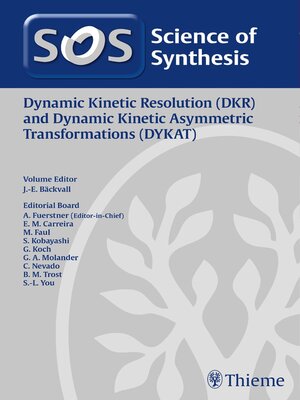Dynamic Kinetic Resolution (DKR) and Dynamic Kinetic Asymmetric Transformations (DYKAT)
ebook
By Jan-E. Bäckvall

Sign up to save your library
With an OverDrive account, you can save your favorite libraries for at-a-glance information about availability. Find out more about OverDrive accounts.
Find this title in Libby, the library reading app by OverDrive.



Search for a digital library with this title
Title found at these libraries:
| Library Name | Distance |
|---|---|
| Loading... |
Principles and applications of DKR and DYKAT
DKR and DYKAT are of ever increasing importance in the synthesis of enantiomerically enriched compounds.
The preparation of enantiomerically pure compounds is of great importance in society today, in particular in pharmaceutical chemistry and in the agrochemical sector. Kinetic resolution is a popular method for differentiating two enantiomers in a racemic mixture that react at different rates with a chiral catalyst or reagent. The drawback of kinetic resolution is that the yield of one pure enantiomer is limited to a maximum of 50%. To overcome this limitation, an in situ racemization of the starting material can be combined with a kinetic resolution. This combination leads to a so called "dynamic kinetic resolution" (DKR), where the two enantiomers are in equilibrium with one another. The slow-reacting enantiomer will continuously be converted into the fast-reacting one, when the latter is transformed into the enantiomerically pure product. Thus, a racemic starting material can be transformed in catalytic processes into a single isomer of a chiral compound in up to 100% yield.
DKR only applies to the resolution of racemic mixtures and the involvement of enantiomers leads to simple kinetics. When diastereomers, either as starting materials or as diastereomeric intermediates, are involved in the resolution process under dynamic conditions (via equilibria between diastereomers), the kinetics is different from DKR. These reactions are classified as "dynamic kinetic asymmetric transformations" (DYKAT).
This volume covers the principles of DKR and DYKAT and presents examples of organocatalytic, chemoenzymatic, and transition-metal catalyzed approaches, including applications in the synthesis of complex, biologically active compounds.







